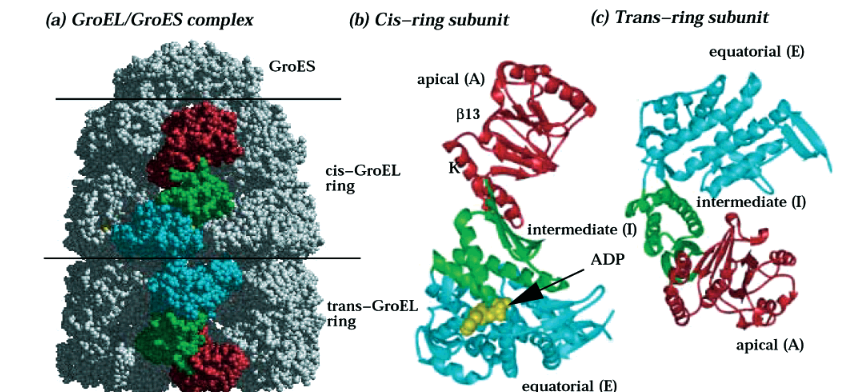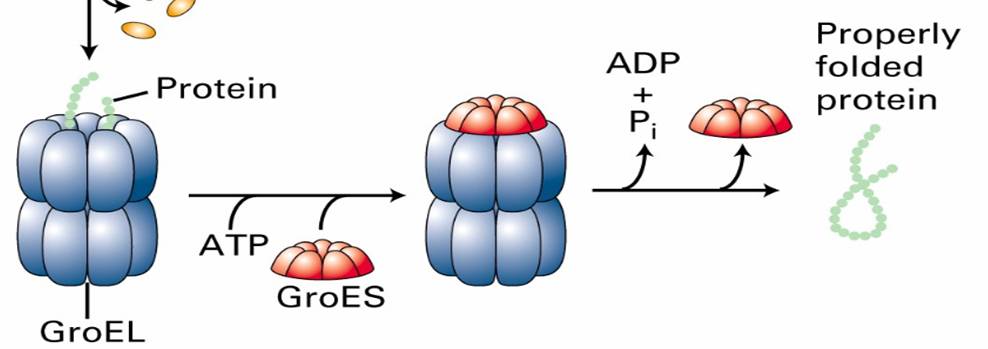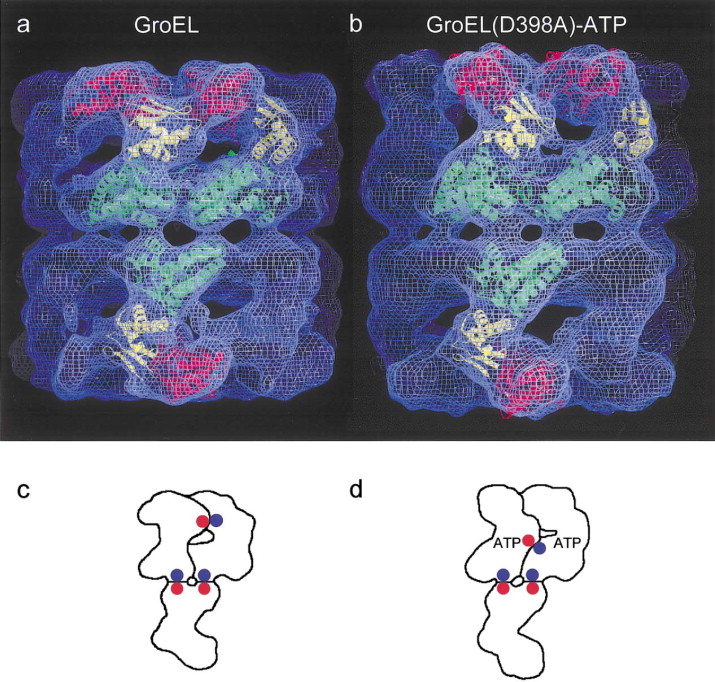Sandbox chaperonins
From Proteopedia
|
Contents |
GroEL
Overview
Bacterial chaperonins, such as GroEL[1], ensure proper folding of proteins by providing optimal micro conditions for folding, and provide aid and recovery for already incorrectly folded proteins and toxic protein aggregates. Improper translation of proteins, mutations among newly transcribed mRNA, or unfavorable cellular conditions (such as excessive heat) can result in partially misfolded or completely misfolded proteins. These partially or completely nonfunctional proteins often aggregate with each other, forming clumps within the cell. These protein aggregates are usually highly toxic to the cell, as they often interfere with vital cellular process, and can disrupt vital cellular structures (such as the cell membrane.) The bacterial chaperonin GroEL provides a proper micro-environment that is able to alleviate protein aggregation, as well as restoring proper structure to proteins, consequently restoring protein function.
Structure and Mechanism
GroEL consists primarily of two 57 KiloDalton heptameric subunits[2]. The first group of heptameric subunits create the space where misfolded proteins can first associate with. This is known as the trans ring. The second group of heptameric proteins allows a specific microenvironment large enough to force improperly folded proteins to assume their correct structure. This is known as the cis ring. Each of these rings have structures that are slightly different, however, they consist of the same domains. The subunits involved in GroEL consists of three domains: apical, intermediate, and equatorial domains. In the apical domain, which faces the cavity of the protein, we find both alpha helices and beta pleated sheets. The apical domain consist of resides 193 to 375. The amino acids in the interior of the first heptameric ring are essential for peptide-GroEL interactions. As such, there is a ring of specific hydrophobic amino acids that form a ring on the interior of this first heptamer, namely Leucine, Isoleucine, Valine, Methionine, Phenylalanine, and Tyrosine. This ring of hydrophobic amino acids interacts with exposed hydrophobic regions on the improperly folding protein, which decreases free energy of the protein, effectively “coaxing” the protein into the GroEL. The intermediate domain connects the apical domain to the equatorial domain. The intermediate domain consist largely of residues 138 to 192, as well as 376 to 410. The equatorial domain, which is found primarily on the outside of the GroEL, consist of residues 1 to 137, as well as 411 to 525[3]. The equitorial domain consists largely of hydrophilic amino acids. It is also here where ATP is able to bind. Upon ATP binding to the equatorial domain, GroES, a roughly 10 kDa cochaperone, can bind to GroEL. Once ATP and the GroES have bound to GroEL, a conformational change happens which forces the improperly folded protein into the second larger cavity within the protein. The “hydrophobic lip” in the first heptameric subunit then retracts away from the core protein, and the substrate of interest is essentially trapped and forced to interact with the amino acids in the apical domains found in the second heptameric subunit. Since the amino acids in the second heptameric ring are strategically hydrophilic, the substrate of interest is then forced to correct its shape and fold properly (hydrophobic amino acids being buried within the protein.) Once this is complete, ATP hydrolysis allows the GroES co-chaperonin to dissociate. It is at this point that the substrate of interest can leave the GroEL. The GroES co-chaperone can also bind to the first heptameric subunit (the trans ring,) thus forcefully ejecting the properly folded protein from GroEL and into the cytosol[4] .
Energetics
ATP is a crucial allosteric regulator for the GroEL protein. Each equatorial domain has the capacity to host an ATP, allowing up to 7 ATP to bind to GroEL. ATP binding to GroEL is believed to follow a cooperative mechanism. Binding of ATP to the first heptameric (trans) ring creates conformational changes within GroEL, allowing the protein of interest to fall into the larger (cis) cavity and fold correctly [5] . ATP hydrolysis (due to intrinsic ATPase activity within the equatorial subunits) allows the properly folded protein to then be released, as the GroES co-chaperone dissociates from GroEL. It is crucial that ATP binds to the GroEL to induce conformational changes that allow GroES to bind, as it has been noted that ADP does not have the same allosteric effect on GroEL at this stage (stage prior to improperly folded polypeptide being ejected into the larger hydrophobic chamber.) ADP bound GroEL promotes dissociation from cochaperone GroES[6]. The ATP bound form of GroEL becomes more elongated then the unaligned GroEL, and these major structural changes involve the apical, equatorial, and intermediate domains.
Disease
More and more research is suggesting that GroEL and chaperonins might have a major role in fighting a number of diseases and cancers associated with improper protein folding and formation of cytotoxic protein aggregates. Diseases involved include a large number of neuro-degenerative diseases (e.g. Alzheimers and Dementia), arthritis and other autoimmune conditions, as well as a large number of vascular diseases [7]. Continued research on the understanding of the structure, mechanism, and role of chaperonins in the body could aid to the discovery of life saving drugs and highly effective treatments for these diseases in the future.
References
- ↑ 4AAR. (n.d.). Retrieved December 13, 2015, from http://www.rcsb.org/pdb/explore/explore.do?structureId=4AAR
- ↑ GroEL Folding Mechanism. (n.d.). Retrieved December 13, 2015, from http://www.udel.edu/chem/bahnson/chem645/websites/Yerkes/GroEL Folding Mechanism.html
- ↑ (n.d.). Retrieved December 12, 2015, from http://www.ccbb.pitt.edu/PDFs/152.pdf
- ↑ Lin et al. Nature Structural and Molecular Biology, March 2008
- ↑ n.d.). Retrieved December 13, 2015, from http://www.sciencedirect.com/science/article/pii/S0092867401006171
- ↑ Result Filters. (n.d.). Retrieved December 13, 2015, from http://www.ncbi.nlm.nih.gov/pubmed/14517228
- ↑ Julia C. Ranford, Anthony R.M. Coates and Brian Henderson (2000) Chaperonins are cell-signalling proteins: the unfolding biology of molecular chaperones. Exp. Rev. Mol. Med. 15 September, http://www-ermm.cbcu.cam.ac.uk/00002015h.htm



